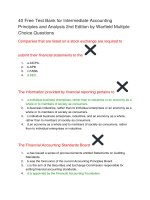Visual six sigma making data analysis lean (2nd edition) by ian cox, marie gaudard
Bạn đang xem bản rút gọn của tài liệu. Xem và tải ngay bản đầy đủ của tài liệu tại đây (23.99 MB, 561 trang )
Visual
Six Sigma
Wiley & SAS Business
Series
The Wiley & SAS Business Series presents books that help senior-level managers with their
critical management decisions.
Titles in the Wiley & SAS Business Series include:
Agile by Design: An Implementation Guide to Analytic Lifecycle Management by Rachel AltSimmons
Analytics in a Big Data World: The Essential Guide to Data Science and Its Applications by Bart
Baesens
Bank Fraud: Using Technology to Combat Losses by Revathi Subramanian
Big Data, Big Innovation: Enabling Competitive Differentiation through Business Analytics by
Evan Stubbs
Business Forecasting: Practical Problems and Solutions edited by Michael Gilliland, Len
Tashman, and Udo Sglavo
Business Intelligence Applied: Implementing an Effective Information and Communications Technology Infrastructure by Michael Gendron
Business Intelligence and the Cloud: Strategic Implementation Guide by Michael S. Gendron
Business Transformation: A Roadmap for Maximizing Organizational Insights by Aiman Zeid
Data-Driven Healthcare: How Analytics and BI Are Transforming the Industry by Laura Madsen
Delivering Business Analytics: Practical Guidelines for Best Practice by Evan Stubbs
Demand-Driven Forecasting: A Structured Approach to Forecasting, Second Edition by Charles
Chase
Demand-Driven Inventory Optimization and Replenishment: Creating a More Efficient Supply
Chain by Robert A. Davis
Developing Human Capital: Using Analytics to Plan and Optimize Your Learning and Development
Investments by Gene Pease, Barbara Beresford, and Lew Walker
Economic and Business Forecasting: Analyzing and Interpreting Econometric Results by John
Silvia, Azhar Iqbal, Kaylyn Swankoski, Sarah Watt, and Sam Bullard
Financial Institution Advantage and the Optimization of Information Processing by
Sean C. Keenan
Financial Risk Management: Applications in Market, Credit, Asset, and Liability Management and
Firmwide Risk by Jimmy Skoglund and Wei Chen
Fraud Analytics Using Descriptive, Predictive, and Social Network Techniques: A Guide to Data
Science for Fraud Detection by Bart Baesens, Veronique Van Vlasselaer, and Wouter Verbeke
Harness Oil and Gas Big Data with Analytics: Optimize Exploration and Production with Data
Driven Models by Keith Holdaway
Health Analytics: Gaining the Insights to Transform Health Care by Jason Burke
Heuristics in Analytics: A Practical Perspective of What Influences Our Analytical World by Carlos
Andre, Reis Pinheiro, and Fiona McNeill
Hotel Pricing in a Social World: Driving Value in the Digital Economy by Kelly McGuire
Implement, Improve and Expand Your Statewide Longitudinal Data System: Creating a Culture of
Data in Education by Jamie McQuiggan and Armistead Sapp
Killer Analytics: Top 20 Metrics Missing from your Balance Sheet by Mark Brown
Mobile Learning: A Handbook for Developers, Educators, and Learners by Scott McQuiggan,
Lucy Kosturko, Jamie McQuiggan, and Jennifer Sabourin
The Patient Revolution: How Big Data and Analytics Are Transforming the Healthcare Experience
by Krisa Tailor
Predictive Analytics for Human Resources by Jac Fitz-enz and John Mattox II
Predictive Business Analytics: Forward-Looking Capabilities to Improve Business Performance by
Lawrence Maisel and Gary Cokins
Statistical Thinking: Improving Business Performance, Second Edition by Roger W. Hoerl and
Ronald D. Snee
Too Big to Ignore: The Business Case for Big Data by Phil Simon
Trade-Based Money Laundering: The Next Frontier in International Money Laundering Enforcement by John Cassara
The Visual Organization: Data Visualization, Big Data, and the Quest for Better Decisions by
Phil Simon
Understanding the Predictive Analytics Lifecycle by Al Cordoba
Unleashing Your Inner Leader: An Executive Coach Tells All by Vickie Bevenour
Using Big Data Analytics: Turning Big Data into Big Money by Jared Dean
Visual Six Sigma, Second Edition by Ian Cox, Marie Gaudard and Mia Stephens
For more information on any of the above titles, please visit www.wiley.com.
Visual
Six Sigma
Making Data Analysis Lean
Ian Cox
Marie A. Gaudard
Mia L. Stephens
Second Edition
Copyright © 2016 by SAS Institute, Inc. All rights reserved.
Published by John Wiley & Sons, Inc., Hoboken, New Jersey.
Published simultaneously in Canada.
No part of this publication may be reproduced, stored in a retrieval system, or transmitted in any
form or by any means, electronic, mechanical, photocopying, recording, scanning, or otherwise,
except as permitted under Section 107 or 108 of the 1976 United States Copyright Act, without
either the prior written permission of the Publisher, or authorization through payment of the
appropriate per-copy fee to the Copyright Clearance Center, Inc., 222 Rosewood Drive, Danvers,
MA 01923, (978) 750-8400, fax (978) 646-8600, or on the Web at www.copyright.com. Requests
to the Publisher for permission should be addressed to the Permissions Department, John Wiley &
Sons, Inc., 111 River Street, Hoboken, NJ 07030, (201) 748-6011, fax (201) 748-6008, or online
at />Limit of Liability/Disclaimer of Warranty: While the publisher and author have used their best
efforts in preparing this book, they make no representations or warranties with respect to the
accuracy or completeness of the contents of this book and specifically disclaim any implied
warranties of merchantability or fitness for a particular purpose. No warranty may be created or
extended by sales representatives or written sales materials. The advice and strategies contained
herein may not be suitable for your situation. You should consult with a professional where
appropriate. Neither the publisher nor author shall be liable for any loss of profit or any other
commercial damages, including but not limited to special, incidental, consequential, or other
damages.
For general information on our other products and services or for technical support, please
contact our Customer Care Department within the United States at (800) 762-2974, outside the
United States at (317) 572-3993 or fax (317) 572-4002.
Wiley publishes in a variety of print and electronic formats and by print-on-demand. Some
material included with standard print versions of this book may not be included in e-books or in
print-on-demand. If this book refers to media such as a CD or DVD that is not included in the
version you purchased, you may download this material at . For
more information about Wiley products, visit www.wiley.com.
Library of Congress Cataloging-in-Publication Data:
Names: Cox, Ian, 1956–
Title: Visual six sigma : making data analysis lean / Ian Cox,
Marie A. Gaudard, Mia L. Stephens.
Description: Second edition. | Hoboken : Wiley, 2016. | Series: Wiley and SAS
business series | Revised edition of Visual six sigma, 2010. | Includes index.
Identifiers: LCCN 2016001878 (print) | LCCN 2016003459 (ebook) |
ISBN 9781118905685 (hardback) | ISBN 9781119222262 (epdf) |
ISBN 9781119222255 (epub)
Subjects: LCSH: Six sigma (Quality control standard) | Decision support
systems. | Decision making—Statistical methods. | Organizational
effectiveness. | BISAC: BUSINESS & ECONOMICS / Strategic Planning.
Classification: LCC HD30.213 .C69 2016 (print) | LCC HD30.213 (ebook) |
DDC 658.4/013—dc23
LC record available at />Cover Design: Wiley
Cover Image: ©Studio-Pro/iStock.com
Printed in the United States of America
10 9 8 7 6 5 4 3 2 1
Contents
Preface to the Second Edition ix
Preface to the First Edition xiii
Acknowledgments xv
About the Authors xvii
PART ONE
BACKGROUND
1
Chapter 1
Introduction 3
Chapter 2
Six Sigma and Visual Six Sigma 7
Chapter 3
A First Look at JMP 27
Chapter 4
Managing Data and Data Quality
PART TWO CASE STUDIES
67
101
Chapter 5
Reducing Hospital Late Charge Incidents 103
Chapter 6
Transforming Pricing Management in a Chemical
Supplier 157
Chapter 7
Improving the Quality of Anodized Parts 223
Chapter 8
Informing Pharmaceutical Sales and Marketing 297
Chapter 9
Improving a Polymer Manufacturing Process 345
Chapter 10 Classification of Cells
437
PART THREE SUPPLEMENTARY MATERIAL 509
Chapter 11 Beyond “Point and Click” with JMP 511
Index 539
vii
Preface to the Second
Edition
The first edition of this book appeared in 2010, so we decided to produce
an updated and expanded second edition. The purpose of the book remains
unchanged—to show how, using the three principles of Visual Six Sigma,
you can exploit data to make better decisions more quickly and easily than you
would otherwise. And, as you might expect given their power and utility, these
principles are also unchanged. However, production of this second edition
allows us to take advantage of some interim developments that make the
implementation of Visual Six Sigma even easier, further increasing the scope
and efficacy of its application. It also allows us to improve and enhance the
content and form of the first edition.
The staying power of Six Sigma as a methodology can be attributed to the
fact that it can provide a common language for, and approach to, project-based
improvement initiatives. Nonetheless, as we pointed out in the first edition,
there is a clear need to evolve the mechanics of Six Sigma both to accommodate the greater availability of data and to address the fact that, historically,
approaches to analyzing data were overly concerned with hypothesis testing, to
the detriment of the hypothesis generation and discovery needed for improvement. We believe that Visual Six Sigma can foster this evolution, and this is part
of our motivation for keeping this text current.
At the same time, the past five years have seen the explosion of “big data,”
at least as an identifiable area that software providers and implementation consultants make strenuous efforts to market to. In this language, the increased
data availability mentioned above is measured using three dimensions: volume,
variety, and velocity. Even though the precise definition of big data is not always
clear, we think there is much for would-be data scientists to learn from the principles of Visual Six Sigma and their application. In addition, if a project-based
approach is warranted, the language of Six Sigma may also be useful.
Although the principles of Visual Six Sigma are general, their effective and
efficient adoption in practice is reliant on good enabling software. The first edition was tied to version 8.01 of JMP, Statistical Discovery software from SAS
Institute® . This second edition has been revised to be consistent with the version current at the time of writing, JMP 12.2.0. Generally, JMP aims to exploit
the synergy between visualization and analysis, and its continuing development
has opened up new possibilities for Visual Six Sigma. In some cases, these are
simply matters of detail and efficiency, but in others there are important new
capabilities we can use.
ix
x
PREFACE TO THE SECOND EDITION
A key feature of the book remains the six self-contained case studies. Given
feedback from the first edition, we are even more convinced of the advantage
of this format in showing how seemingly disparate techniques can be used in
concert to accomplish something useful. We interweave the new capabilities of
JMP where they usefully support or extend the case studies.
Consistent with the requirements of Visual Six Sigma in the new era of big
data, we have introduced two new chapters:
◾ Chapter 4, “Managing Data and Data Quality,” precedes the case studies
and addresses the management of data and data quality. Data quality, at
an organizational level, is a ubiquitous topic that is often seen as mainstream to the point of being boring. However, the importance of data
quality for project teams and anyone making decisions with data cannot be overstated. As we shall see, the Visual Six Sigma context leads to
some important and interesting nuances.
◾ Chapter 11, “Beyond ‘Point and Click’ with JMP,” follows the case
studies and shows how to go beyond the interactive usage of JMP for
discovery and improvement. No matter how simple or complex, the
performance of empirical models always degrades over time. Once
improvements are made, there is always the need to monitor and adapt
with an appropriate frequency. In turn, this means that analyses need
to be repeated as new data arrive, and this is often best done with an
element of automation.
The case studies appear in Part Two of the book. Chapter 4 is appended
to Part One, making this section four chapters long. Given the nature of the
content, Chapter 11 appears as a singleton chapter in Part Three.
Finally, we have tried to make the case studies easier to use by having clearer
typographic separation between the narrative (consisting of the why, the what,
and the findings of each technique as it is used in a specific context) and the
“how to” steps required in JMP. As well as helping to keep things concise, this
arrangement better accommodates users with different levels of prior familiarity
with JMP, and may make it easier to use other software should this be required
or mandated.
As in the first edition, we have used different fonts to help identify the
names of data tables, of columns in data tables, and commands. Data table
names are shown in MeridienLTStd-Bold, the names of columns (which are
variable names) are shown in italic Helvetica, and the names of commands and
other elements of the user interface are shown in bold Helvetica.
We are now living through a time of rapid change in the world of data
analysis. We have tried to reflect this in our changes and additions. We hope
that this second edition on Visual Six Sigma contains even more of interest for
current or would-be Six Sigma practitioners, or more generally for anyone with
PREFACE TO THE SECOND EDITION
xi
a stake in exploiting data for the purpose of gaining new understanding or of
driving improvement.
Supplemental Materials
We anticipate that you will follow along, using JMP, as you work through the
case studies and Chapters 4 and 11. You can download a trial copy of JMP
at www.jmp.com/try. Chapter 10 requires JMP Pro. You can request a trial
version of JMP Pro at www.jmp.com/en_us/software/jmp-pro-eval.html. JMP
instructions in this book are based on JMP 12.2.0. Although the menu structure
may differ if you use a different version of JMP, all the functionality described
in this book is available in JMP 12.2.0 or newer versions.
The data sets used in the book are available at />visualsixsigma. This folder contains a journal file, Visual Six Sigma.jrn, that
contains links to the data tables, scripts, and add-ins discussed in this book. The
color versions of the exhibits shown in the book are also available here. Exhibits
showing JMP results were taken using JMP 12.2.0 running on Windows.
Preface to the First Edition
The purpose of this book is to show how, using the principles of Visual Six
Sigma, you can exploit data to make better decisions more quickly and easily
than you would otherwise. We emphasize that your company does not need to
have a Six Sigma initiative for this book to be useful. Clearly there are many
data-driven decisions that, by necessity or by design, fall outside the scope of a
Six Sigma effort, and in such cases we believe that Visual Six Sigma is ideal. We
seek to show that Visual Six Sigma can be used by a lone associate, as well as a
team, to address data-driven questions, with or without the support of a formal
initiative like Six Sigma.
To this end, we present six case studies that show Visual Six Sigma in
action. These case studies address complex problems and opportunities faced
by individuals and teams in a variety of application areas. Each case study
was addressed using the Visual Six Sigma Roadmap, described in Chapters 2
and 3. As these case studies illustrate, Visual Six Sigma is about exploration
and discovery, which means that it is not, and never could be, an entirely
prescriptive framework.
As well as using the case studies to convey the Visual Six Sigma Roadmap,
we also want to use them to illustrate Visual Six Sigma techniques that you can
reuse in your own setting. To meet this goal, sometimes we have deliberately
compromised the lean nature of the Visual Six Sigma Roadmap in order to take
the opportunity to show you extra techniques that may not be strictly necessary to reach the conclusion or business decision. Striking the balance this
way means that you will see a wider repertoire of techniques from which to
synthesize an approach to Visual Six Sigma that works for you.
Because of its visual emphasis, Visual Six Sigma opens the doors for
non-statisticians to take active roles in data-driven decision making, empowering them to leverage their contextual knowledge to pose relevant questions,
get good answers, and make sound decisions. You may find yourself working
on a Six Sigma improvement project, a design project, a data mining inquiry,
or a scientific study—all of which require decision making based on data. After
working through this book, we hope that you will be able to make data-driven
decisions in your specific situation quickly, easily, and with greater assurance.
How This Book Is Organized
This book is organized in two parts. Part I contains an introductory chapter that
presents the three Visual Six Sigma strategies, a chapter on Visual Six Sigma,
xiii
xiv
PREFACE TO THE FIRST EDITION
and a chapter introducing JMP statistical software (from SAS® Institute), which
will be used throughout the case studies.
Case studies are presented in Part Two. These case studies follow challenging real-world projects from start to finish. Through these case studies, you will
gain insight into how the three Visual Six Sigma strategies combine to expedite
project execution in the real world. Each case study is given its own chapter,
which can be read independently from the rest. A concise summary of the storyline opens each case study. Although these case studies are real, we use fictitious
names for the companies and individuals to preserve confidentiality.
Within each case study, visualization methods and other statistical techniques are applied at various stages in the data analysis process in order to better
understand what the data are telling us. For those not familiar with JMP, each
case study also contains the relevant how-to steps so that you may follow along
and see Visual Six Sigma in action.
The data sets used in the case studies are available at
.com/visualsixsigma. Here you can also find the exhibits shown in the case
studies, allowing you to see screen captures in color. Additional Visual Six Sigma
resource materials will be made available on the website, as appropriate.
A Word about Software
The ideas behind Visual Six Sigma are quite general, but active learning—in our
view, the only kind of learning that works—requires that you step through the
case studies and examples in this book to try things out for yourself. For more
information about JMP, and to download a trial version of the software, visit
www.jmp.com/demo.
JMP is available on Windows, Mac, and Linux platforms. The step-by-step
instructions in this book assume that you are working in Windows. Mac and
Linux users should refer to the JMP documentation for details on differences.
This book is based on JMP version 8.0.1.
Acknowledgments
Stating the obvious, this book would not exist without its first edition. Even
though some have moved on, we remain deeply indebted to all those listed
who made the first edition possible. Most importantly, we want to thank Leo
Wright of SAS and Phil Ramsey of the North Haven Group, LLC, our co-authors
on the first edition, who provided some of the original case studies and helped
to make this book possible.
Both editions of the book were substantially improved by suggestions from
Mark Bailey of SAS. We greatly appreciate his time, interest, valuable feedback, and insights. We want to thank Andy Liddle, now of Process Insight
Consulting Limited, who assisted with the review of the original version of “Improving a Polymer Manufacturing Process” (now Chapter 9). We also want to
thank Volker Kraft of SAS, who provided valuable feedback in connection with
updates to this case study for the book’s second edition.
This project was greatly facilitated by Stacey Hamilton and Stephenie Joyner
of SAS Publishing. Their support, encouragement, and attention to detail at
every step of this adventure were invaluable.
Finally, we would like to thank Jon Weisz and Curt Hinrichs of JMP for
their support and encouragement in updating this book. And, as before, a special thank-you goes to John Sall, Bradley Jones, Chris Gotwalt, Xan Gregg,
Brian Corcoran, and the JMP Development Team for their continuing work
on a visionary product that makes Visual Six Sigma possible.
xv
About the Authors
Ian Cox currently works in the JMP Division of SAS. Before joining SAS in
1999, he worked for Digital Equipment Corporation, Motorola, and BBN Software Solutions Ltd. and has been a consultant for many companies on data
analysis, process control, and experimental design. A Six Sigma Black Belt, he
was a Visiting Fellow at Cranfield University and is a Fellow of the Royal Statistical Society. Cox holds a Ph.D. in theoretical physics.
Marie A. Gaudard is a consultant specializing in statistical training with the
use of JMP. She is currently a statistical writer with the JMP documentation
team. She earned her Ph.D. in statistics in 1977 and was a professor of statistics
at the University of New Hampshire from 1977 until 2004. She has been heavily
involved in statistical consulting since 1981. Gaudard has worked with a variety of clients in government agencies, medical areas, and manufacturing. She
has extensive experience in consulting and training in the areas of Six Sigma,
Design for Six Sigma, forecasting and demand planning, and data mining.
Mia L. Stephens is an academic ambassador with the JMP division of SAS.
Prior to joining SAS, she was an adjunct professor at the University of New
Hampshire and a partner in the North Haven Group, a statistical training and
consulting company. Also a coauthor of JMP Start Statistics: A Guide to Statistics
and Data Analysis Using JMP, Fifth Edition and Building Better Models with JMP Pro,
she has developed courses and training materials, taught, and consulted within
a variety of manufacturing and service industries. Stephens holds an M.S. in
statistics from the University of New Hampshire.
xvii
Visual
Six Sigma
PART
ONE
Background
Visual Six Sigma: Making Data Analysis Lean, Second Edition. Ian Cox, Marie A. Gaudard, Mia L. Stephens
© 2016 by SAS Institute, Inc. Published by John Wiley & Sons, Inc.
C H A P T E R
1
Introduction
Visual Six Sigma: Making Data Analysis Lean, Second Edition. Ian Cox, Marie A. Gaudard, Mia L. Stephens
© 2016 by SAS Institute, Inc. Published by John Wiley & Sons, Inc.
3
4
VISUAL SIX SIGMA
WHAT IS VISUAL SIX SIGMA?
Visual Six Sigma is about leveraging interactive and dynamic graphical displays
to help transform data into sound decisions. It is not an algorithm. It is a creative process that employs visual techniques in the discovery of new and useful
knowledge, leading to quicker and better decisions than do the methods in
general use today. It signals a new generation of Six Sigma techniques.
At the heart of Six Sigma is the concept of data-driven decision making, that
is, of exploiting the data from measurements or simulations at various points
in the life cycle of your product or service. Visual Six Sigma aims to produce
better alignment between Six Sigma practice and the key idea of discovery,
providing benefits for all those who have a stake in solving problems and in
making improvements through data.
Visual Six Sigma consists of three main strategies:
1. Using dynamic visualization to literally see the sources of variation in
your data.
2. Using exploratory data analysis techniques to identify key drivers and
models, especially for situations involving many variables.
3. Using confirmatory statistical methods only when the conclusions are
not obvious.
Six Sigma programs often use the so-called DMAIC approach for team-based
process improvement or problem-solving efforts. The acronym DMAIC stands
for the major phases in a team’s project: Define, Measure, Analyze, Improve, and
Control. DMAIC provides a structure for a team’s efforts, just as an overall Six
Sigma program provides a structure for a company’s efforts. Each phase of
DMAIC comes with a list of techniques that are considered appropriate in that
phase; the team moves from one phase to another, using this sequence of techniques as a general guide. In a similar way, Six Sigma projects aimed at design
follow various structures, such as Define, Measure, Analyze, Design, and Validate
(DMADV) and Identify, Design, Optimize, and Validate (IDOV).
Visual Six Sigma is not a replacement for the DMAIC, DMADV, or IDOV
frameworks. Rather, Visual Six Sigma supports these frameworks by simplifying
and enhancing methods for data exploration and discovery whenever they are
needed. In addition, when circumstances make a full-blown project-based or
team-based approach undesirable or unworkable, Visual Six Sigma can still be
used by individual contributors such as you. In a nutshell, Visual Six Sigma helps
to make the DMAIC and design structures—and data analysis in general—lean.
Moving beyond Traditional Six Sigma
It is our belief that the tools, techniques, and workflows in common use with
Six Sigma efforts are typically not aligned with the key idea of discovery. In
INTRODUCTION
5
the early days of Six Sigma, relevant data rarely existed, and a team was often
challenged to collect data on its own. As part of the Measure phase, a team usually conducted a brainstorming session to identify which features of a process
should be measured. In some sense, this brainstorming session was the team’s
only involvement in hypothesis generation. The data collected were precious,
and hypothesis testing methods were critical in separating signals from noise.
Project teams struggling with a lack of useful data generally rely on an abundance of subjective input, and often require hypothesis testing to minimize the
risk of bad decisions. This emphasis on hypothesis testing is reasonable in an
environment where data are sparse. In contrast, today’s Six Sigma teams often
find warehouses of data that are relevant to their efforts. Their challenge is to
wade through the data to discover prominent features, to separate the remarkable from the unremarkable.
These data-rich environments call for a shift in emphasis from confirmatory methods, such as hypothesis testing, to exploratory methods, with a major
emphasis on the display of data to reveal prominent features that are hidden
in the data. Since the human interpretation of the data context is a vital part
of the discovery process, these exploratory techniques cannot be fully automated. Also, with large quantities of data, hypothesis testing itself becomes less
useful—statistical significance comes easily and may have little to do with practical importance.
Of course, the simple abundance of data in a warehouse does not guarantee
its relevance for improvement or problem solving. In fact, it is our experience
that teams working in what they believe to be data-rich environments sometimes find that the available data are of poor quality or are largely irrelevant
to their efforts. Visualization methods can be instrumental in helping teams
quickly reach this conclusion. In these cases, teams need to revert to techniques
such as brainstorming, cause-and-effect diagrams, and process maps, which
drive efforts to collect the proper data. But, as we shall see, even in situations
where only few relevant data are available, visualization techniques, supported
as appropriate by confirmatory methods, prove invaluable in identifying telling
features of the data.
Making Data Analysis Lean
Discovery is largely supported by the generation of hypotheses—conjectures
about relationships and causality. Today’s Six Sigma teams, and data analysts
in the business world in general, are often trained with a heavy emphasis on
hypothesis testing, with comparatively little emphasis given to hypothesis generation and discovery. They are often hampered in their problem-solving and
improvement efforts by the inability to exploit exploratory methods, which
could enable them to make more rapid progress, often with less effort.
6
VISUAL SIX SIGMA
In recent times, we have seen incredible advances in visualization methods,
supported by phenomenal increases in computing power. We strongly believe
that the approaches now allowed by these methods are underutilized in current
Six Sigma practice. It is this conviction that motivated us to write the first edition
of this book and, following its success, to produce a second edition that takes
advantage of recent software advances. We hope you find this book useful as
you shape and build your own real-world Six Sigma experience.
Requirements of the Reader
This leads to another important point, namely, that you are “part of the system.”
Discovery, whether practiced as an individual or as a team sport, involves both
divergent and convergent thinking; both creativity and discipline are required
at different times. You should bear this in mind when forming a team or when
consulting with individuals, since each person will bring his or her own skill
set, perspective, and strength to the discovery process.
Given the need to be data driven, we also need to recognize one of the basic
rules of using data, which is that any kind of analysis that treats data simply as a
list of numbers is doomed to failure. To say it differently: All data are contextual,
and it is this context and the objectives set out for the project that must shape
the analysis and produce useful recommendations for action. As a practitioner,
your main responsibility should always be to understand what the numbers in
the data actually mean in the real world. In fact, this is the only requirement
for putting the ideas in this book into practice in your workplace.
C H A P T E R
2
Six Sigma and Visual
Six Sigma
Visual Six Sigma: Making Data Analysis Lean, Second Edition. Ian Cox, Marie A. Gaudard, Mia L. Stephens
© 2016 by SAS Institute, Inc. Published by John Wiley & Sons, Inc.
7
8
VISUAL SIX SIGMA
T
his chapter introduces the key ideas behind Six Sigma and Visual Six Sigma;
our focus is on the latter. Six Sigma is a potentially huge topic, so we only
have space to mention some of its essential ideas. There are already numerous well-written books and articles dealing with the many and diverse aspects
of Six Sigma as commonly practiced.1 We also note that today, digital tools
(software, databases, visual media, etc.) are leveraged extensively in Six Sigma
initiatives.2
Our goal in this chapter is to provide an overview of Six Sigma so that you
start to see how Visual Six Sigma fits into this picture. However, it is worth
pointing out in advance that you can only gain a proper appreciation of the
power of visualization techniques by working with data that relate to real problems in the real world.
BACKGROUND: MODELS, DATA, AND VARIATION
There is no doubt that science and technology have transformed the lives of
many and will continue to do so. Like many fields of human endeavor, science
proceeds by building pictures, or models, of what we think is happening. These
models can provide a framework in which we attempt to influence or control
inputs so as to provide better outputs. Unlike the models used in some other
areas, the models used in science are usually constructed using data that arise
from measurements made in the real world.
At the heart of the scientific approach is the explicit recognition that we may
be wrong in our current world view. Saying this differently, we recognize that
our models will always be imperfect, but by confronting them with data, we can
strive to make them better and more useful. Echoing the words of George Box,
one of the pioneers of industrial statistics, we can say, “Essentially, all models
are wrong, but some are useful.”3
MODELS
The models of interest in this book can be conceptualized as shown in
Exhibit 2.1. This picture demands a few words of explanation:
◾ In this book, and generally in Six Sigma, the outcomes of interest to us
are denoted with a Y. For example, Y1 in Exhibit 2.1 could represent the
event that someone will apply for a new credit card after receiving an
offer from a credit card company.
◾ Causes that may influence a Y will be shown as an X. To continue the
example, X1 may denote the age of the person receiving the credit
card offer.
◾ Rather than using a lengthy expression such as “we expect the age of
the recipient to influence the chance that he or she will apply for a credit
SIX SIGMA AND VISUAL SIX SIGMA
X4
X1
Causes We
X2
Understand
X3
X5
X6
9
Causes We Don’t Understand,
Know About, or Care About
System of Interest
Y1 Measured Effects
or Outcomes of
Y2
Interest
Y1 = Signal Function1(X1, X2, X3) + Noise Function1(X4, X5, X6)
Y2 = Signal Function2(X1, X2, X3) + Noise Function2(X4, X5, X6)
Exhibit 2.1 Modeling of Causes before Improvement
card after receiving an offer,” we can just write Y = f(X). Here, f is called
a function, and Y = f(X) describes how Y changes as X changes. If we think
that Y depends on more than one X, we simply write an expression like
Y = f(X1, X2). Since the function f describes how the inputs X1 and X2
affect Y, the function f is called a signal function.
◾ Note that we have two different kinds of causes: (X1, X2, X3), shown
in the diagram with solid arrows, and (X4, X5, X6), shown with dotted arrows. The causes with dotted arrows are the causes that we do
not know about or care about, or causes that it is impossible or uneconomic to control. Often, these are called nuisance or noise variables. For
example, X4 could be the number of credit cards that the recipient of
the offer already has, or the time since the recipient received a similar
offer. The function that represents the combined effect of the noise variables on Y is called a noise function, and the result is sometimes referred
to simply as error.
◾ Just because we do not know about the noise variables does not mean
that they do not influence Y. If X4, X5, or X6 change, as they typically
will, then they will necessarily lead to some apparently inexplicable variation in the outcome Y, even when we do our best to keep X1, X2, and X3
fixed. For example, whether an offer recipient applies for a new credit
card may well be influenced by the number of credit cards that the recipient already has.
As you can see in the exhibit, a key aspect of such a model is that it focuses
on some specific aspects (i.e., X1, X2, and X3) in order to better understand
them. By intention or simply lack of current knowledge, the model necessarily
omits some aspects that may actually be important (X4, X5, and X6).
Depending on whether you are being optimistic or pessimistic, Six Sigma
can be associated with improvement or problem solving. Very often, an explicit
model relating the Ys to Xs may not exist; to effect an improvement or to solve
a problem, you need to develop such a model. The process of developing this
10
VISUAL SIX SIGMA
X5
X1
Causes We X2
Understand X3
X4
X6
Causes We Don’t Understand,
Know About, or Care About
System of Interest
Y1 Measured Effects
or Outcomes of
Y2
Interest
Y1 = Signal Function3(X1, X2, X3, X4) + Noise Function3(X5, X6)
Y2 = Signal Function4(X1, X2, X3, X4) + Noise Function4(X5, X6)
Exhibit 2.2 Modeling of Causes after Improvement
model first requires arriving at a starting model and then confronting that model
with data to try to refine it. Later in this chapter, in the section “Visual Six Sigma:
Strategies, Process, Roadmap, and Guidelines,” we discuss a process for refining
the model.
If you succeed in refining it, then the new model might be represented as
shown in Exhibit 2.2. Now X4 has a solid arrow rather than a dotted arrow and
is within the scope of the signal function rather than the noise function. When
we gain a new understanding of a noise variable, we gain leverage in explaining
the outcome (Y) and so can often make the outcome more favorable to us. In
other words, we are able to make an improvement.
The use of the term error to refer to a noise function has technical origins,
and its use is pervasive, though noise might be a better term. Useful models
that encompass variation rely on making a correct separation of the noise and
the signal implied by the data. Indeed, the inclusion of noise in the model is
essentially the definition of a statistical model (see the section “Variation and
Statistics”), and in such models the relevance or statistical significance of a signal
variable is assessed in relation to the noise.
MEASUREMENTS
The use of data-driven models to encapsulate and predict how important aspects
of a business operate is still a new frontier. Moreover, there is a sense in which
a scientific approach to business is more challenging than the pursuit of science itself. In science, the prevailing notion is that knowledge is valuable for
its own sake. But for any business striving to deliver value to its customers
and stakeholders—usually in competition with other businesses doing the same
thing—knowledge does not necessarily have an intrinsic value. This is particularly
so since the means to generate, store, and use data and knowledge are in themselves value-consuming, including database and infrastructure costs, training
costs, cycle time lost to making measurements, and so on.
SIX SIGMA AND VISUAL SIX SIGMA
11
Therefore, for a business, the only legitimate driving force behind a scientific, data-driven approach that includes modeling is a failure to produce or deliver
what is required. This presupposes that the business can assess and monitor what
is needed, which is a nontrivial problem for at least two reasons:
1. A business is often a cacophony of voices, expressing different views as
to the purpose of the business and needs of the customer.
2. A measurement process implies that a value is placed on what is being
measured, and it can be very difficult to determine what should be
valued.
It follows that developing a useful measurement scheme can be a difficult,
but vital, exercise. Moreover, the analysis of the data that arise when measurements are actually made gives us new insights that often suggest the need
for making new measurements. We will see some of this thinking in the case
studies that follow.
OBSERVATIONAL VERSUS EXPERIMENTAL DATA
Before continuing, it is important to note that the data we will use come in two
types, depending on how the measurements of Xs and Ys are made: observational data and experimental data. Exhibit 2.1 allows us to explain the crucial
difference between these two types of data.
1. Observational data arise when, as we record values of the Ys, the values
of the Xs are allowed to change at will. This occurs when a process runs
naturally and without interference.
2. Experimental data arise when we deliberately manipulate the Xs and then
record the corresponding Ys.
Observational data are collected with no control over associated Xs. Often
we simply assume that the Xs are essentially constant over the observational
period, but sometimes the values of a set of Xs are recorded along with the
corresponding Y values.
In contrast, the collection of experimental data requires us to force variation
in the Xs. This involves designing a plan that tells us exactly how to change
the Xs in the best way, leading to the topic of experimental design, or design
of experiments (DOE). DOE is a powerful and far-reaching approach that has
been used extensively in manufacturing and design environments.4 Today, DOE
is finding increasing application in nonmanufacturing environments as well.5
The book Optimal Design of Experiments: A Case Study Approach guides readers in
designing and analyzing experiments using JMP.6
In both manufacturing and nonmanufacturing settings, DOE is starting to
find application in the Six Sigma world through discrete choice experiments.7
12
VISUAL SIX SIGMA
In such experiments, users or potential users of a product or service are given
the chance to compare attributes and express their preferences or choices. This
allows market researchers and developers to take a more informed approach
to tailoring and trading off the attributes of the product or service in advance.
Because one attribute can be price, such methods allow you to address an important question: What will users pay money for? We note that JMP has extensive,
easy-to-use facilities for both the design and analysis of choice models.
Even in situations where DOE is relevant, preliminary analysis of observational data is advised to set the stage for designing the most appropriate and
powerful experiment. The case studies in this book deal predominantly with
the treatment of observational data, but Chapters 7 and 9 feature aspects of
DOE as well.
SIX SIGMA
Some common perceptions and definitions of Six Sigma include:
◾ A management philosophy
◾ Marketing hype
◾ A way to transform a company
◾ A way to create processes with no more than 3.4 defects per million
opportunities
◾ Solving problems using data
◾ A way to use training credits
◾ Something a company has to do before Lean
◾ Making improvements using data
◾ A way to make money from consulting, training, and certification
◾ A pseudo-religion
◾ A way to get your next job
◾ Something a company does after Lean
In spite of this diversity of perspectives, there seems to be broad agreement
that a Six Sigma initiative involves a variety of stakeholders and is a projectbased method utilizing cross-functional teams. A performance gap is the only
legitimate reason for spending the time and resources needed to execute a Six
Sigma project. From this point of view, questions such as the following are vital
to a Six Sigma deployment:
◾ How big should the performance gap be to make a project worth doing?
◾ How can you verify that a project did indeed have the expected impact?






![Classical Music For Dummies (2nd Edition) by David Pogue & Scott Speck [Dr.Soc] _ www.bit.ly/taiho123](https://media.store123doc.com/images/document/2016_11/18/medium_prs1479473519.jpg)


